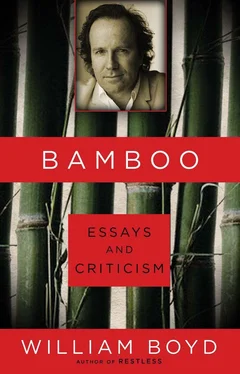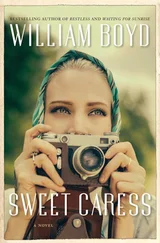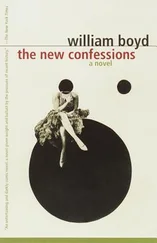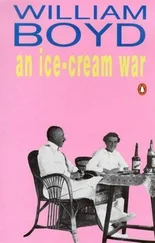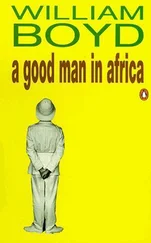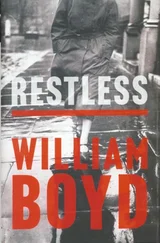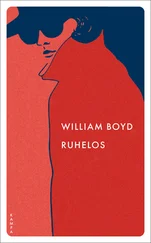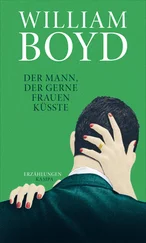Have you learned anything from writing these original screenplays for yourself to direct which you can bring to bear on writing adaptations for other people?
I really don’t know. I’m reluctant to create rules like, “If you’re writing a scene and it’s seven pages long and it isn’t over yet then you’re in trouble,” because in fact you may not be. Or to insist, “Don’t put in any camera moves,” because camera moves might actually be useful. But I’m now much more aware of the issue, “Is this going to be a problem to shoot?” When I was writing for other people, that was their problem not mine. Take a dinner-party scene, for example, with ten people chattering away around a table. There’s really only a bog-standard way of filming that kind of scene, and because I know how long it takes and how much coverage you have to shoot and how it still looks like a bunch of people talking at a table, I now think, “Maybe this scene shouldn’t take place at a dinner party after all. Maybe it would be more interesting if they were walking through a park.” It’s not going to justify the sheer effort of shooting it, because you can do it in a more elegant or intriguing way. If you look at the opening of Reservoir Dogs, Tarantino set himself exactly that problem and obviously thought, “To hell with this,” and got someone to walk round and round with a steadicam. If you weren’t in shot when you were talking and he didn’t have coverage for it, so what? It’s actually quite a good way of shooting a lot of people talking at a table, although you may find when you come to cut it that a really crucial line is masked by somebody’s head, whereas if you’d storyboarded it and shot it from five or six different static positions you’d have got your coverage. The directorial influence makes itself felt more in the details than the big picture. Some establishing shots are key, for example, but do you really need to see people arriving in their cars and unlocking their front doors? You know you’ll cut that during editing, so why write it in the first place? Unless you happen to be Michael Mann and have seven cameras running simultaneously, there’s no interesting way of shooting someone arriving home. So maybe a better way of writing a scene like that is to have someone inside the house hearing the car pull up, followed by the driver bursting through the front door. Everyone will be able to envisage what happened outside. That sort of writing decision is all as a result of having stood behind a camera.
The vast majority of your scripts are adaptations. Do you think that Hollywood somehow perceives British screenwriters as more literary?
I think that’s a fair point. Maybe the classic serial generates that feeling. Masterpiece Theatre is hugely popular in America. But I also think it’s an industry-wide taste — or problem. For every original script commissioned there are four or five adaptations. Again, it’s driven by this fear of failure: “It’s a really successful book. Let’s make it into a movie.” The art of film is not best served by constantly doing adaptations, because of the problems inherent in shifting from one form to the other. It’s like putting pop songs on soundtracks. Isn’t it better to have a proper score? Isn’t that what film music is all about? It’s not about taking ten hit records and sticking them on so you get a great CD. Similarly, I feel, in a vaguely purist way, that film is best served if the script was always destined to be a film.
Which, looking at your filmography, is rather ironic.
That’s my point. That’s the nature of the beast. I bet most screenwriters would rather write something based on their own ideas than on this best-selling novel or that work of non-fiction. It’s not just books; they’re adapting TV shows, comic strips, other films. Traffic is an adaptation of a British television series. That’s why, in any scriptography, there will always be three to one in favour of adaptations. I was quite lucky that the first two scripts I did were original scripts. I think you have to separate adaptations and original scripts, because there are totally different sets of mental gears engaged in producing them.
How quickly did you adapt to writing scripts?
You can learn the grammar of a screenplay incredibly quickly. That’s why there are so many screenwriters out there. Any resting actor can produce a screenplay which looks exactly like a Robert Towne screenplay in terms of format but ultimately you have to fall back on whatever storytelling ability you have. You also have to understand what you can do with film and what you can’t. You’d have to be a very talented director, for example, to make a forty-five-page dialogue scene work. My advice to aspiring screenwriters is that if you see a film you really like, get hold of the screenplay and read it watching the movie simultaneously, with the remote control close at hand. You begin to understand the rhythms and cadences of film. Why is this scene so arresting? Stop. Rewind. Look again. Because you’re hearing this person talking, but you’re actually seeing the other person listening. And you realize it’s much more powerful that way. You learn.
Though that might not be written down.
It’s surprising how much is written down. I know, having directed myself, that you do a master shot and close-ups and reverses so that you can cut it any way you want. But if, for example, one character is announcing the news of the other character’s wife’s infidelity, then you will often write in the script, “Hold on a big close-up of John.” That’s simple storytelling. It’s more important to see John’s reaction than it is to see Fred speaking the words. And if you, the writer, think the moment should be played that way, then you haven’t even got a chance of getting it done like that if you don’t write it down. The rule of thumb is: if you want it in the film, make sure it’s in the script. Of course, stuff that’s in the script often doesn’t get shot, which is particularly galling for the writer. You come to the editing stage and say, “Where’s that close shot of Sally turning round as he walks off?” “Oh, we never did it.” “But it’s on page forty-three.” “Well, we were pressed for time.” But a good film writer will put these shots in, all the same.
Or not, depending on the advice you listen to. Aspiring screenwriters are often told precisely the opposite: the fewer camera directions the better.
In fact, the first screenplays I read were by Harold Pinter, who’s extremely sparing with directions, so my first screenplays were similarly spare. I don’t think William Goldman even puts scene headings in, it’s just “Cut to …” But there are moments where a scene has no dialogue so you have to write directions, and you would be better off writing them in a way that you think they would be well shot.
Of course, a script — particularly a spec script — isn’t simply a blueprint for a film, it’s also a sales tool for a project, so it has to be as readable as it is shootable. For example, directions in parentheses to indicate how the dialogue should be spoken.
It’s called “grandstanding” in Hollywood. When I was writing for Universal and Warner it was understood that this kind of thing would go in. It makes an easier read for overtaxed executives, because you’re telling them what the emotion is and they don’t have to deduce whether a character is happy or sad. Now, because I’ve worked more with actors and I understand an actor’s take on a script, I tend to strip that stuff away. Actors hate things like, “Ted (with a thin smile),” because you’re saying, “This is how I want you to act it.” But if you’re writing a film for a Hollywood studio you write it in a different way. A script has to be so many things in its life, and is going to be read by so many people who have a vested interest in saying no, that you want to give it your best shot — and there are all sorts of ways you can garnish it so it seems user-friendly. Hollywood is very conventional, in its own way. They want the script to be presented in the right typeface — Courier — to be printed on the right paper — American letter-size is not the same as our A4—and to be bound with three clips — brass not silver — else they’ll say, “Foreign,” and throw it away. British screenwriters who take their scripts down to Kall Kwik and get a plastic binding are handicapping themselves. When I was writing a lot in Hollywood, I used to buy great stacks of American paper and brass clips precisely so that it “looked right.”
Читать дальше
